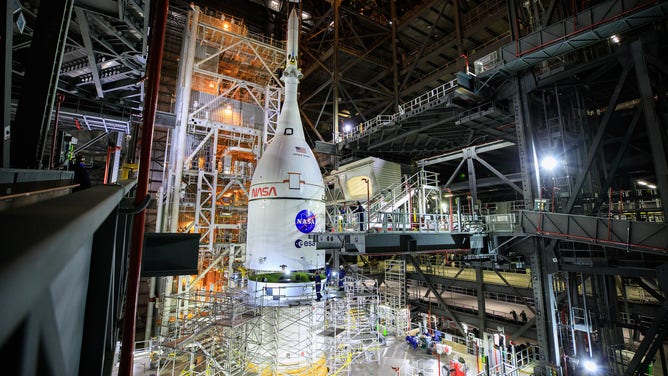NASA sets launch date to test Artemis moon rocket
After years of waiting first Artemis launch scheduled for 2022

The Orion spacecraft for NASA's Artemis I mission, fully assembled with its launch abort system, is lifted above the Space Launch System (SLS) rocket in High Bay 3 of the Vehicle Assembly Building at Kennedy Space Center in Florida on Oct. 20, 2021. The stacking of Orion on top of the SLS completes assembly for the Artemis I flight test.
(NASA/Frank Michaux)
UPDATE: NASA is now targeting no earlier than March for the Artemis-1 launch from Kennedy Space Center.
PREVIOUS STORY:
The first rocket designed to carry astronauts to the moon for the first time in 50 years is fully assembled in Florida, prompting NASA to announce a launch date.
The space launch system or SLS, rocket, and Orion spacecraft were stacked inside the historic Vehicle Assembly Building at NASA's Kennedy Space Center early this week. The rocket will be the first of the agency's new moon program, Artemis, the liftoff early next year on an uncrewed test flight.
In October 2021, with all the rocket parts in place, NASA deputy associate administrator for exploration systems Tom Whitmeyer said the agency is targeting a window in February for the Artemis-1 launch, opening on Feb. 12 and closing on Feb. 27.
Artemis-1 will launch the Orion spacecraft from KSC launchpad 39B and orbit the moon before returning to Earth. No astronauts will be on board the first test flight, but later Artemis-2 will fly four astronauts on a similar path.
Fully stacked, the rocket stands 322 feet tall, higher than the Statue of Liberty.
During an October news conference, NASA managers reflected on the Hunter's Moon this week, saying it reminded them of the mission ahead: returning astronauts to the lunar surface, but this time to establish an ongoing presence.
"It's funny anytime we have a full moon I look up here and I kind of think about the mission that we've got, and it always gets me pumped up," KSC Exploration Ground Systems manager Mike Bolger said.
NASA's most recent estimate for SLS development will total $9.1 billion, more than $2 billion above the previous number approved by Congress.
Even under a new administration, NASA continued to push toward putting the first woman and first person of color on the moon by 2024. President Donald Trump moved the original goal of 2028 up by four years during his time in office. President Joe Biden has not expressed interest in pushing it back.
While this will be the maiden launch of SLS, it will mark Orion's second spaceflight but first to deep space.
"Orion and SLS will prove out the vehicle design take all the experiences from this test flight and then carry those forward to upcoming Artemis missions, refining our processes and efficiencies and making the changes when necessary," Cathy Koerner, Orion program manager, said.
In 2014, Orion launched on a United Launch Alliance Delta IV Heavy from Florida. The spacecraft orbited the Earth twice during that test flight.
Artemis-1 will be "a much more rigorous, a mission to the moon, which is 1,000 times farther from Earth than where the space station flies today and will demonstrate the capability of our spacecraft in a more extreme radiation environment," Kerner said.
Throughout the journey, Orion will document its trip through cameras mounted to the spacecraft. At the furthest point, about 270,000 miles from Earth, Orion will take some "selfies" with Earth, explained Artemis-1 mission manager Mike Sarafin.
The spacecraft will be put to the test on re-entry. It will need to slow from Mach 32 to zero throughout 20-minutes.
"When we come back from the moon, it's going to come back far faster and far hotter than we did on that high Earth orbit mission," Sarafin said.
The current launch date depends on a wet dress rehearsal in January. NASA will proceed just like it would on the real launch day, fueling the rocket and conducting a complete run-through of the countdown.
If the launch doesn't go in February, Sarafin said, another opportunity opens March 12. The launch windows are dependent on the positioning of the moon and Earth.
According to NASA's most recent timeline, if Artemis-1 goes well, astronauts will complete a flight test by 2023.